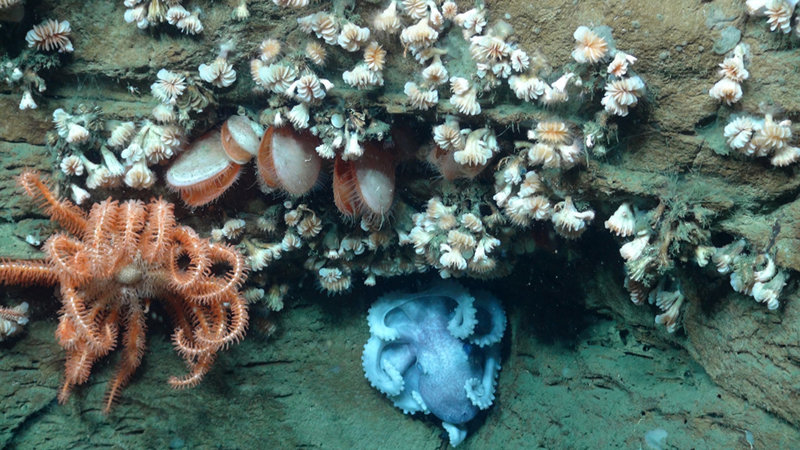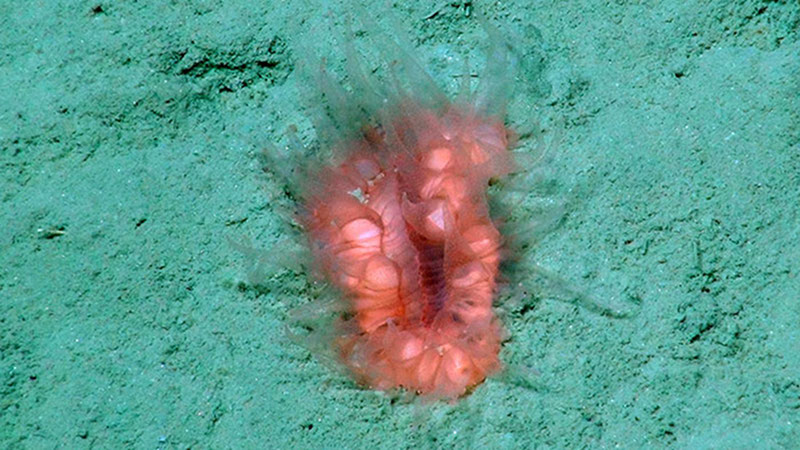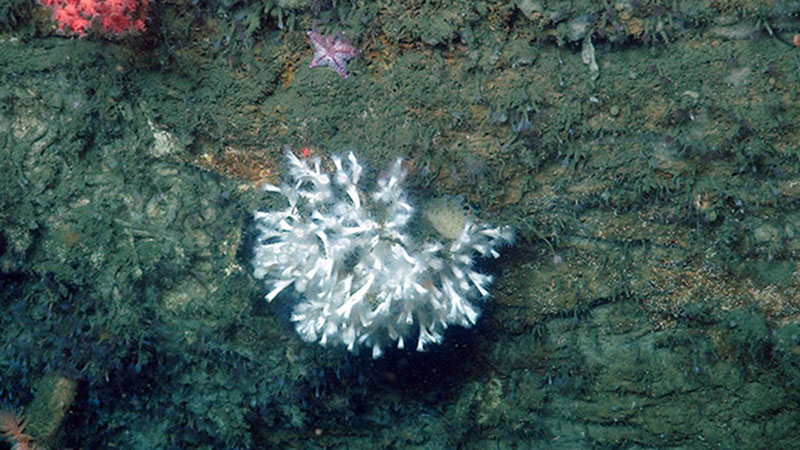
By Katharine Coykendall, Geneticist - U.S. Geological Survey
Cheryl Morrison, Research Geneticist - U.S. Geological Survey
May 13, 2013

On this project we have encountered many species of invertebrates living together on the steep canyon walls. Here an octopus, sea star, bivalves, and dozens of cup coral all share the same overhang. The cup corals are Desmophyllum, one of the species targeted by geneticists for taxonomic study. Image courtesy of Deepwater Canyons 2013 - Pathways to the Abyss, NOAA-OER/BOEM/USGS. Download larger version (jpg, 1.2 MB).
Species diversity, which is a count of the number of species present in a defined space and the abundance of each of those species, is an important ecological measure in ecology and conservation biology. As marine scientists, why would we want to quantify the number of species in the ocean and describe them? Preserving biodiversity is a central tenet in conservation biology and often cited as a goal in recovery and management plans for threatened or fragile ecosystems. Before we can ascertain if we are doing a good job in protecting the biodiversity of a region, we need to know what’s there.

Flabellum, a solitary cup coral, with its tentacles extended into the water column. Like other deepwater corals, Flabellum’s evolutionary history and closest relatives are difficult to discern. Image courtesy of Deepwater Canyons 2013 - Pathways to the Abyss, NOAA-OER/BOEM/USGS. Download larger version (jpg, 1.2 MB).
Molecular taxonomists use molecular tools such as differences in DNA sequences between organisms to classify organisms. The DNA code greatly influences the traits we can measure and count, but not always directly. There are a few challenges that face taxonomists.
One challenge is environmental influences on traits. Height differences may reflect quality of nutrition and not inherited differences, for example.
Another challenge is hybridization between species. Sometimes hybrids can have traits that look like an intermediate blend between two species. For example, species A has 40 spines, species B has 60 spines, and their hybrid has 50 spines. In some cases, hybrids can look like either parental species depending on the trait, like having the same number of spines as species A, but the same number of toes as species B.
A third challenge, especially relevant in marine invertebrates, is the morphology of early larval stages can be quite different than that of adult stages of the same species. Molecular tools can clarify classification ambiguities and aid taxonomy by going back to the source of these morphological traits, the DNA code.
By examining a stretch of DNA present in the taxa under study and counting the differences between them, we can get a quantifiable measure of differentiation between taxa. We can select a threshold, say three percent different, to define difference between species. A commonly used gene across a broad array of organisms is cytochrome c oxidase (COX1), which is the enzyme at the end of the respiratory electron transport chain and so occurs in most aerobic (oxygen-requiring) organisms. Seem straightforward? Well it’s not.
In order for this to work, the stretch of DNA, or gene, to be compared between taxa should change over time at a constant rate. That isn’t always the case, though. Some genes are under strong selective pressure to not mutate, meaning any change that happens results in a faulty protein and death. Conversely, if a change occurs randomly in the DNA that leads to a new and improved protein that leads to a fitter organism, that’s also going to affect the rate of change in the DNA.
So there may be a three percent difference in the DNA sequence of a gene between two species of sea urchins, but only a one percent difference between species of chemosynthetic mussels at that same gene because they are in different environments, with different evolutionary histories and perhaps under different selection pressure. To help resolve this, sometimes researchers use several genes to reach consensus.

A small cluster of Lophelia coral growing on a vertical rock wall in Norfolk Canyon. Lophelia is capable of forming large deepwater reefs in some areas. Image courtesy of Deepwater Canyons 2013 - Pathways to the Abyss, NOAA-OER/BOEM/USGS. Download larger version (jpg, 1.3 MB).
In deepwater corals, taxonomy is particularly tricky. First of all, they live in remote places and are hard to sample. Secondly, it has been shown that some genes used for classification in other organisms, like COX1 mentioned above, don’t have the same power to classify coral species. These genes mutate much more slowly and don’t discern taxa that are clearly very different from each other based on other information.
In an examination of the order of stony coral, Scleractinia, Romano, and Cairns (2000) showed that, instead of seven groups within the order, based on morphology and the fossil record, there are two main groups based on DNA. In our lab, we work on several deepwater stony corals such as the solitary cup corals Flabellum and Desmophyllum, and reef-building corals like Lophelia and Madrepora.
We hope to clarify the classification and evolutionary relationships among these organisms using additional genetic information and more samples like those found in our Mid-Atlantic Canyons cruises.
We also are interested in invertebrates that live in close association with the coral, such as galatheiod crabs (squat lobsters). Galatheiod crabs illustrate another challenge in taxonomy, that of cryptic species. Cryptic species are especially challenging to traditional taxonomy because they look the same, yet differ substantially in their DNA. Using DNA information, other scientists have found that some “species” of these crabs are actually more than one.
With information from DNA, careful reconsideration of morphology may reveal consistent differences to help distinguish the genetic lineages. Little is known about the life histories, behaviors, and abundances of species we collect off the coast of the eastern U.S. seaboard. By collecting many specimens of squat lobsters, we hope to add to our knowledge of the species richness and abundance present in these remote and fragile ecosystems.

A squat lobster makes its home among various deep-sea corals. Though most galatheoids share a similar body structure and general appearance, there are many different species. Image courtesy of Deepwater Canyons 2013 - Pathways to the Abyss, NOAA-OER/BOEM/USGS. Download larger version (jpg, 912 KB).